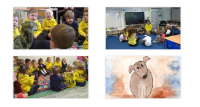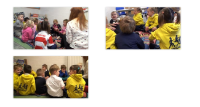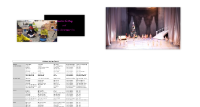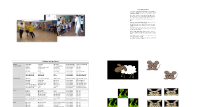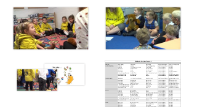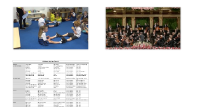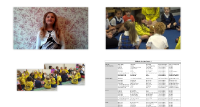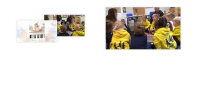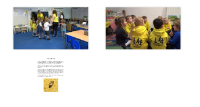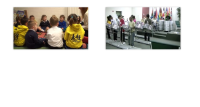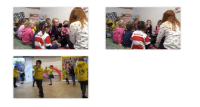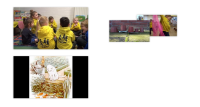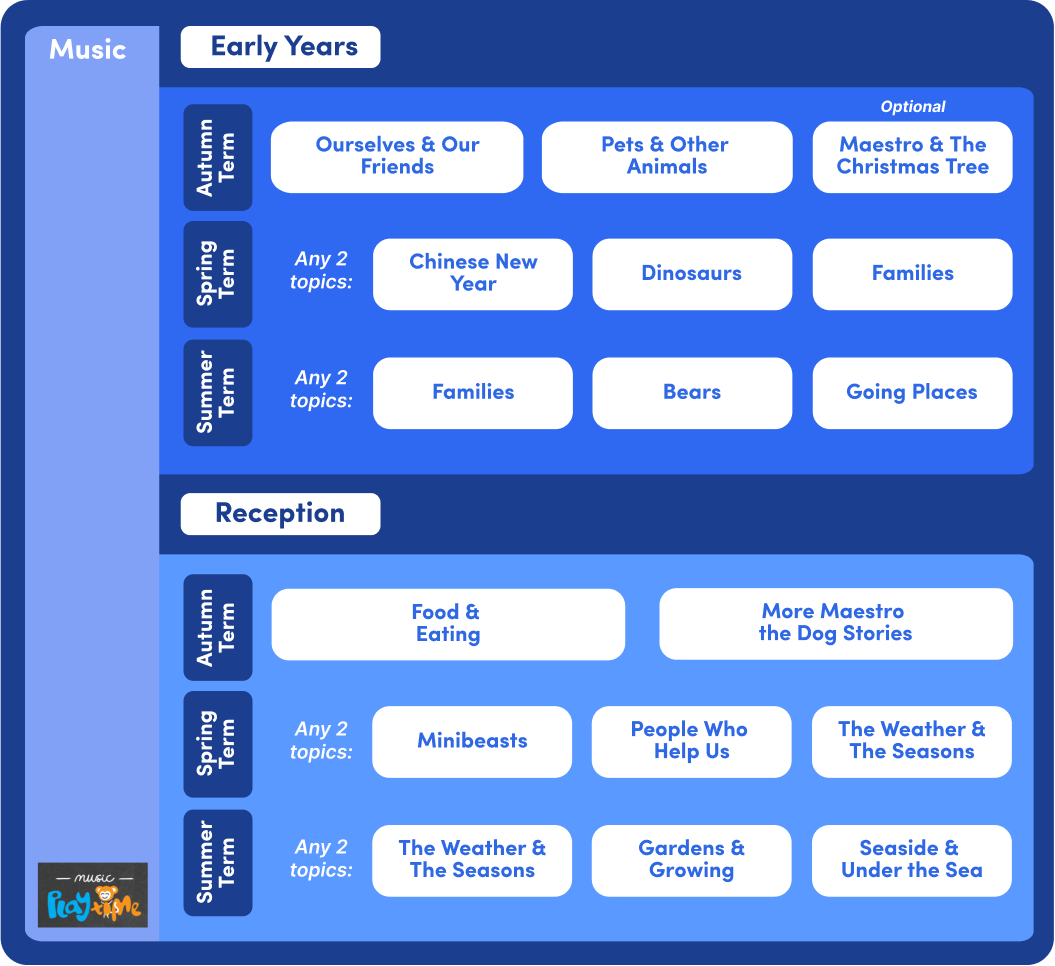Dinosaurs Level: Early Grades
Music Unit Description
This unit is about dinosaurs. It focuses on the difference between singing and chanting, and on loud and quiet dynamics.
Elements
- Pitch: High pitched and low pitched sounds.
- Dynamics: Louder or quieter sounds.
- Duration: Long or short notes, RHYTHM.
- Timbre: The individual quality of a sound.
Resources
- Untuned percussion instruments
- Book: Noisy Dinosaurs – Noisy Books (Board book) by Felicity Brooks ISBN 9780746097847 Publisher: Usborne
- Early Grades Dinosaur Counters (e.g. C&D make)
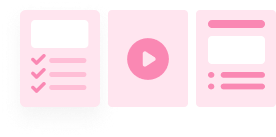
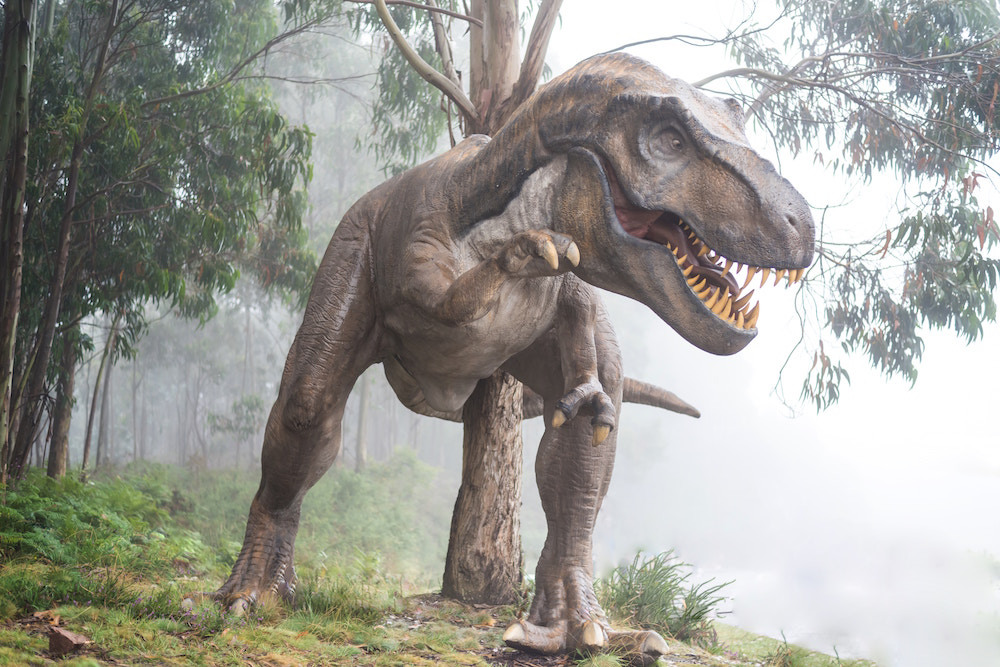
What's That Noise? (timbre)
What sound could this be? The children guess. It's a dinosaur (well not really, but it might have sounded like this!)
Timbre
Timbre is the distinctive sound that enables us to tell one voice, instrument or sound apart from another eg mum's voice sounds different from teacher's voice. Animals do this too, of course - lambs and ewes recognise each other's sound from all the other sheep in the flock.
Dinosaur Rhythms (rhythm, pulse)
With everyone sitting in a circle, first model (demonstrate) for the children how to clap some dinosaur names. I've chosen three that sound different because they have a different number of syllables. Then everyone tap a steady pulse on knees as you say the names in random order and the children clap the name-rhythms in response, like this:

- Rex
- Rap-tor
- Din-o-saur
I find that the children enjoy saying how many claps each word has. The youngest children take a while to learn to count sounds and may randomly say the first number that comes into their heads. They soon learn from other children by hearing the right answers, and saying and clapping each name twice also helps.

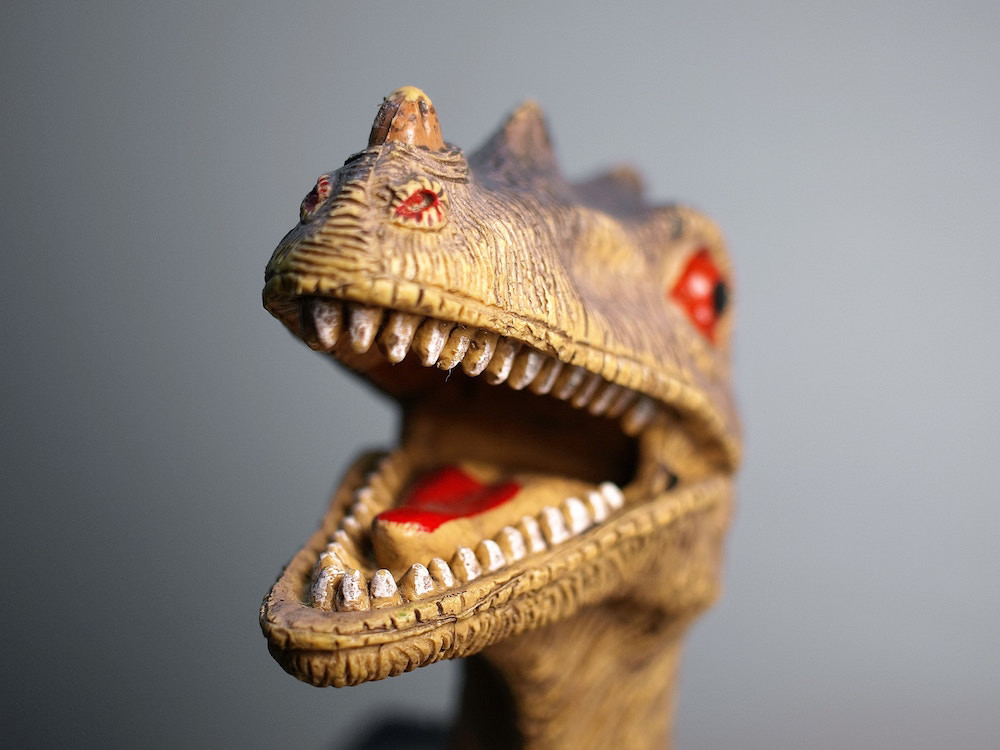
Dinosaur Lullaby (timbre, pitch)
First ask the children Have you brought your talking voice? Get them into the habit of replying Yes we have, Yes we have! Then teach Dinosaur Lullaby using sleepy voices for the first two lines, with a scary roar at the end of line 3, then a Mummy speaking voice for the last line, when the children all stand up. You can choose a small group of children to be Mummy Dinosaur. Sophie wanted Daddy Dinosaur to have his turn at roaring too so we did it again!
- Dinosaur asleep in bed
- Has a pillow for his head
- In the morning mummy roars
- Get up little dinosaurs!
And this is what we did with the song ...
Extension
The children could learn to play the tune on chime bars using G and E.
- Dinosaur Lullaby ©Music-Playtime: Arts Enterprise Limited

Dinosaurs' Jaws and Paws (rhythm, pulse)
Mime a Dinosaur
First of all say the words in a rhythmical way and show the children how to mime the actions of 'great big jaws and pointy teeth', 'little paws and great big feet' and looking horrified (or pleased, or excited) if you saw one one your street.
Body Percussion Dinosaur
Everyone practise tapping knees straight after you say the words, pointy teeth, great big feet and on your street. Then ask the children to make body sounds too, at the end of each verse eg 'little paws and great big feet' could be lighly clapping hands and then stamping feet.
Instruments Dinosaur
Divide the group into three and give out different sounding instruments to each group. After the last line of each verse, the corresponding group plays:
- pointy teeth - claves (tap, tap, tap)
- great big feet - drums (boom, boom ,boom)
- on your street - bells/tambourines (sshhhhaakkke)
- Dinosaurs have
- Great big jaws and
- pointy teeth
- ___
- Dinosaurs have
- Little paws and
- Great big feet
- ___
- What would you do
- If you saw one
- On your street?
Sing the Song (pitch)
Finally, sayHave you brought your singing voice? and teach the tune too. When this is known the children could add the instruments or boady percussion again, at the end of each verse.
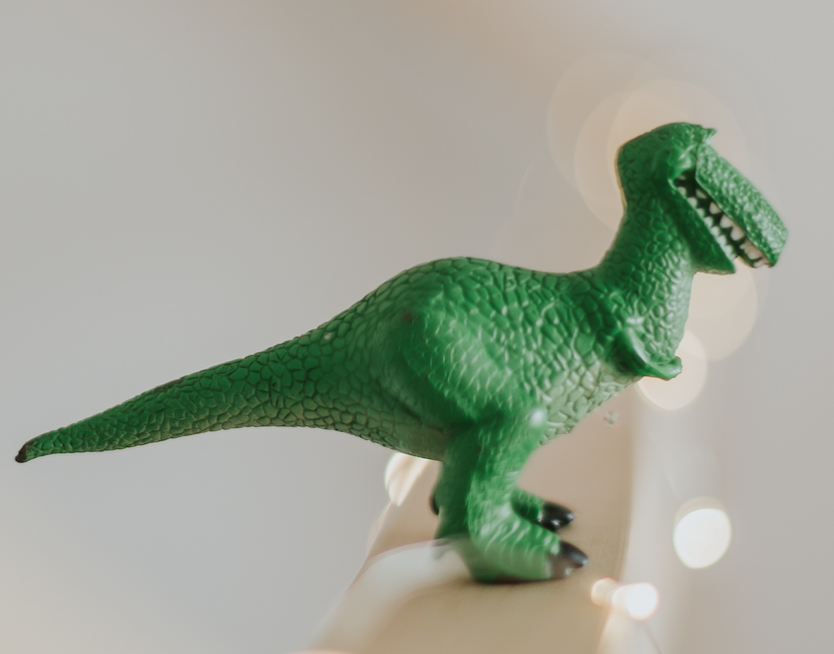
- Dinosaurs Jaws and Paws ©Music-Playtime: Arts Enterprise Limited

Dinosaur Body Sounds (dynamics)
What body quiet/loud sounds can we make with our hands? (washing hands movement: quiet clapping: loud). With our feet? (stamp: loud, shuffle: quiet). With our voices?
With everyone in a circle, the teacher alternates, at random, saying:
- Some dinosaurs are quiet (children make quiet sounds)
- Some dinosaurs are loud (children make loud sounds)
Loud and Quiet Dinosaurs (dynamics)
Here are some ways in which the children can explore dynamics. For the best learning experience, children need to talk about what they are doing, with the teacher there to supply new words. This works well in a small, supervised group. Ask the children to:
- Find out how to play a drum louder: hit it from a greater height, then quieter: hit it closer to the instrument.
- find an instrument that makes quiet sounds
- find an instrument that makes loud sounds
- find an instrument that can make loud AND quiet sounds
Next demonstrate, then encourage children to play the rhythm of Din-o-saur with a little wait in between each time (shake, shake, shake … shake, shake, shake)
Everyone sit in a circle with an instrument each. When the leader plays loudly the children play loudly. When the leader plays quietly, they play quietly.
Book suggestion
Noisy Dinosaurs – Noisy Books (Board book) by Felicity Brooks ISBN 9780746097847 Publisher: Usborne
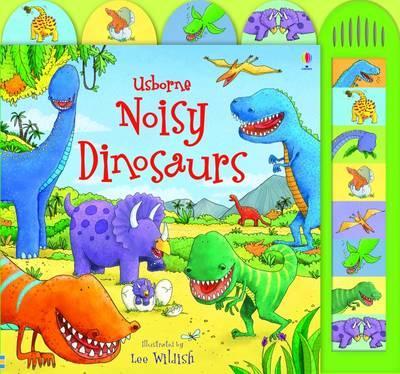
What sort of songs do dinosaurs sing? (pitch)
This is each child's chance to take a turn at making up a dinosaur song. First you will need to model how to make high and low vocal sounds then ask the children take turns at making up a dinosaur family song using high and low sounds. Don't worry about whether the children will be able to think what to do because this is an improvising activity where they make up and structure the sounds as they go on.
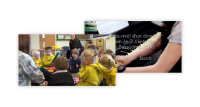
High and Low Boomwhackers (pitch)
The bassoon, which the children can hear in the final video on this page, is basically a long tube. The longer the tube, the lower the sound which is why the bassoon is much lower-pitched than a recorder. A fun way to let the children experience this is to buy a pack of boomwhackers. The different sized tubes make different pitched sounds and you really can whack without fear of breaking them! Here are a few of the ways children can use boomwhackers:
- whack them on the floor
- hit the tube in the middle
- hit the end of the tube with a piece of card
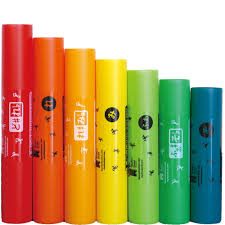
The children seemed to have understood high and low pitch when I'd previously asked them in the context of singing but what happened later shows the need for the same concept to be explored in a different way - hence the need for music education to be a 'Spiral Curriculum'.
Notice how the children all thought the longer tube made the higher sound even though they saw me whack the higher-pitched one and the lower-pitched one! They were looking rather than listening and they had already learned that high means 'tall' in a visual context. Once they really listened, they experienced the meaning of higher and lower pitch in sound and I was able to explain that long tubes make lower pitched sounds than short ones. Many children also mistake high and low for volume, as in television controls.
More Boomwhacker sounds:
L'apres-midi d'un Dinosaur by Gordon Jacob (pitch, tempo)
The children can listen to a bassoon in the video below. This music is about what a dinosaur does in the afternoon! The title is in French. It is low-pitched, slow music played on a big woodwind instrument called the bassoon and on the electronic piano. The children walk heavily to the music, like a contented dinosaur. The dinosaur goes to sleep at the end and has sweet dreams.

Dinosaur Hunt (mathematics, counting and sorting)
Use Early Grades Dinosaur Counters (eg C&D make). Hide different colored dinosaurs all around the room and provide same-color boxes. When the children find a dinosaur they put it in the matching-color box. Count the dinosaurs up in each box at the end of the morning/afternoon.


What's That Noise? (timbre)
What sound could this be? The children guess. It's a dinosaur (well not really, but it might have sounded like this!)
Timbre
Timbre is the distinctive sound that enables us to tell one voice, instrument or sound apart from another eg mum's voice sounds different from teacher's voice. Animals do this too, of course - lambs and ewes recognise each other's sound from all the other sheep in the flock.
Dinosaur Rhythms (rhythm, pulse)
With everyone sitting in a circle, first model (demonstrate) for the children how to clap some dinosaur names. I've chosen three that sound different because they have a different number of syllables. Then everyone tap a steady pulse on knees as you say the names in random order and the children clap the name-rhythms in response, like this:

- Rex
- Rap-tor
- Din-o-saur
I find that the children enjoy saying how many claps each word has. The youngest children take a while to learn to count sounds and may randomly say the first number that comes into their heads. They soon learn from other children by hearing the right answers, and saying and clapping each name twice also helps.


Dinosaur Lullaby (timbre, pitch)
First ask the children Have you brought your talking voice? Get them into the habit of replying Yes we have, Yes we have! Then teach Dinosaur Lullaby using sleepy voices for the first two lines, with a scary roar at the end of line 3, then a Mummy speaking voice for the last line, when the children all stand up. You can choose a small group of children to be Mummy Dinosaur. Sophie wanted Daddy Dinosaur to have his turn at roaring too so we did it again!
- Dinosaur asleep in bed
- Has a pillow for his head
- In the morning mummy roars
- Get up little dinosaurs!
And this is what we did with the song ...
Extension
The children could learn to play the tune on chime bars using G and E.
- Dinosaur Lullaby ©Music-Playtime: Arts Enterprise Limited

Dinosaurs' Jaws and Paws (rhythm, pulse)
Mime a Dinosaur
First of all say the words in a rhythmical way and show the children how to mime the actions of 'great big jaws and pointy teeth', 'little paws and great big feet' and looking horrified (or pleased, or excited) if you saw one one your street.
Body Percussion Dinosaur
Everyone practise tapping knees straight after you say the words, pointy teeth, great big feet and on your street. Then ask the children to make body sounds too, at the end of each verse eg 'little paws and great big feet' could be lighly clapping hands and then stamping feet.
Instruments Dinosaur
Divide the group into three and give out different sounding instruments to each group. After the last line of each verse, the corresponding group plays:
- pointy teeth - claves (tap, tap, tap)
- great big feet - drums (boom, boom ,boom)
- on your street - bells/tambourines (sshhhhaakkke)
- Dinosaurs have
- Great big jaws and
- pointy teeth
- ___
- Dinosaurs have
- Little paws and
- Great big feet
- ___
- What would you do
- If you saw one
- On your street?
Sing the Song (pitch)
Finally, sayHave you brought your singing voice? and teach the tune too. When this is known the children could add the instruments or boady percussion again, at the end of each verse.

- Dinosaurs Jaws and Paws ©Music-Playtime: Arts Enterprise Limited

Dinosaur Body Sounds (dynamics)
What body quiet/loud sounds can we make with our hands? (washing hands movement: quiet clapping: loud). With our feet? (stamp: loud, shuffle: quiet). With our voices?
With everyone in a circle, the teacher alternates, at random, saying:
- Some dinosaurs are quiet (children make quiet sounds)
- Some dinosaurs are loud (children make loud sounds)
Loud and Quiet Dinosaurs (dynamics)
Here are some ways in which the children can explore dynamics. For the best learning experience, children need to talk about what they are doing, with the teacher there to supply new words. This works well in a small, supervised group. Ask the children to:
- Find out how to play a drum louder: hit it from a greater height, then quieter: hit it closer to the instrument.
- find an instrument that makes quiet sounds
- find an instrument that makes loud sounds
- find an instrument that can make loud AND quiet sounds
Next demonstrate, then encourage children to play the rhythm of Din-o-saur with a little wait in between each time (shake, shake, shake … shake, shake, shake)
Everyone sit in a circle with an instrument each. When the leader plays loudly the children play loudly. When the leader plays quietly, they play quietly.
Book suggestion
Noisy Dinosaurs – Noisy Books (Board book) by Felicity Brooks ISBN 9780746097847 Publisher: Usborne

What sort of songs do dinosaurs sing? (pitch)
This is each child's chance to take a turn at making up a dinosaur song. First you will need to model how to make high and low vocal sounds then ask the children take turns at making up a dinosaur family song using high and low sounds. Don't worry about whether the children will be able to think what to do because this is an improvising activity where they make up and structure the sounds as they go on.

High and Low Boomwhackers (pitch)
The bassoon, which the children can hear in the final video on this page, is basically a long tube. The longer the tube, the lower the sound which is why the bassoon is much lower-pitched than a recorder. A fun way to let the children experience this is to buy a pack of boomwhackers. The different sized tubes make different pitched sounds and you really can whack without fear of breaking them! Here are a few of the ways children can use boomwhackers:
- whack them on the floor
- hit the tube in the middle
- hit the end of the tube with a piece of card

The children seemed to have understood high and low pitch when I'd previously asked them in the context of singing but what happened later shows the need for the same concept to be explored in a different way - hence the need for music education to be a 'Spiral Curriculum'.
Notice how the children all thought the longer tube made the higher sound even though they saw me whack the higher-pitched one and the lower-pitched one! They were looking rather than listening and they had already learned that high means 'tall' in a visual context. Once they really listened, they experienced the meaning of higher and lower pitch in sound and I was able to explain that long tubes make lower pitched sounds than short ones. Many children also mistake high and low for volume, as in television controls.
More Boomwhacker sounds:
L'apres-midi d'un Dinosaur by Gordon Jacob (pitch, tempo)
The children can listen to a bassoon in the video below. This music is about what a dinosaur does in the afternoon! The title is in French. It is low-pitched, slow music played on a big woodwind instrument called the bassoon and on the electronic piano. The children walk heavily to the music, like a contented dinosaur. The dinosaur goes to sleep at the end and has sweet dreams.

Dinosaur Hunt (mathematics, counting and sorting)
Use Early Grades Dinosaur Counters (eg C&D make). Hide different colored dinosaurs all around the room and provide same-color boxes. When the children find a dinosaur they put it in the matching-color box. Count the dinosaurs up in each box at the end of the morning/afternoon.
